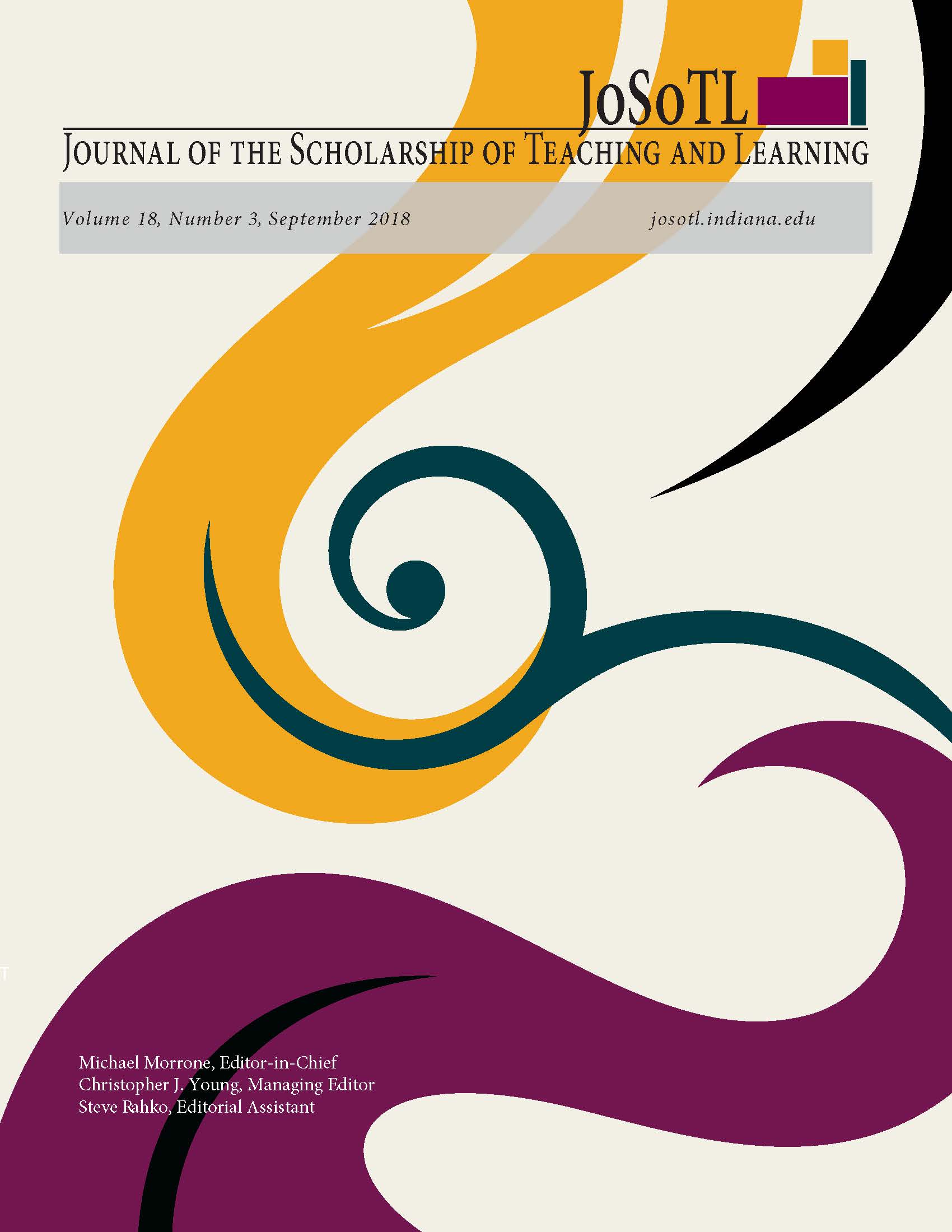Personal Explorations in the Study of Ethnic and Race Relations
Main Article Content
Abstract
Many have discussed the inherent problems in teaching race and ethnic relations courses. Students often come to class with preconceived ideas about their social world, and a range of feelings and experiences including confusion, biases and misconceptions. Therefore, significant barriers to learning exist prior to the first day of class. To address these challenges, I developed a teaching strategy that created a student-centered, non-threatening learning environment where students could thoughtfully discuss and collaborate on group projects covering emotionally charged subjects. In doing so I organized my course, Race and Ethnic Relations, around the students’ use of family histories. This essay includes qualitative data from student projects, and their reflections on the effeciveness of this assignment. Student reflections revealed their relative comfort in holding discussions and presenting information on sensitive and challenging topics.
Keywords:
Student-centered learning, student collaboration, race and ethnic relations, and ethnic family histories
Downloads
Article Details
- Authors retain copyright and grant the Journal of the Scholarship of Teaching and Learning (JoSoTL) right of first publication with the work simultaneously licensed under a Creative Commons Attribution License, (CC-BY) 4.0 International, allowing others to share the work with proper acknowledgement and citation of the work's authorship and initial publication in the Journal of the Scholarship of Teaching and Learning.
- Authors are able to enter separate, additional contractual agreements for the non-exclusive distribution of the journal's published version of the work (e.g., post it to an institutional repository or publish it in a book), with an acknowledgement of its initial publication in the Journal of the Scholarship of Teaching and Learning.
- In pursuit of manuscripts of the highest quality, multiple opportunities for mentoring, and greater reach and citation of JoSoTL publications, JoSoTL encourages authors to share their drafts to seek feedback from relevant communities unless the manuscript is already under review or in the publication queue after being accepted. In other words, to be eligible for publication in JoSoTL, manuscripts should not be shared publicly (e.g., online), while under review (after being initially submitted, or after being revised and resubmitted for reconsideration), or upon notice of acceptance and before publication. Once published, authors are strongly encouraged to share the published version widely, with an acknowledgement of its initial publication in the Journal of the Scholarship of Teaching and Learning.
References
Adams, M., Bell, L.A. and Griffin, P. (2007). Teaching for Diversity and Social Justice. New York: Routledge.
Bain, K. (2004). What the Best College Teachers Do. Cambridge, MA: Harvard University Press.
Bohmer, S. and Oka, K. (2007). Teaching Affirmative Action: An Opportunity to Apply, Integrate, and Reinforce Sociological Concepts. Teaching Sociology 35(4), 334-49.
Chaisson, R. L. (2004). A Crack in the Door: Critical Race Theory in Practice at a Predominantly White Institution. Teaching Sociology 32(3), 345-57.
Crosby, D. B. (2012). Meeting the Challenge: Teaching Sensitive Subject Matter. The Journal of Effective Teaching 12(2), 91-104.
Downey, D. J. and Torrecilha, R. (1994). Sociology or Race and Ethnicity: Strategies for Comparative Multicultural Courses. Teaching Sociology 22(3), 237-47.
Denzin, N. and Lincoln (2002). The Qualitative Inquiry Reader. Thousand Oaks, CA: Sage Publications.
Fritschner, L. M. (2001). Lessons about Race in Introductory Sociology. Teaching Sociology 29(1), 110-15.
Goldsmith, P. A. (2006). Learning to Understand Inequality and Diversity: Getting Students Past Ideologies. Teaching Sociology 34(3), 263-77.
Haltinner, K. (2014). Teaching Race and Anti-Racism in Contemporary America. New York, NY: Springer Publishing Company.
Hollander, J. A. (2002). Learning to Discuss: Strategies for Improving the Quality of Class Discussion. Teaching Sociology 30(3), 317-27.
Kohut, A. and Dimock. M. (2013). Resilient American Values: Optimism in an Era of Growing Inequality and Economic Difficulty. Washington, DC: Council on Foreign Relations.
Jones, K. and Jones, J.L. (2008). Making Cooperative Learning Work in the College Classroom: An Application of the ‘Five Pillars’ of cooperative Learning to Post-Secondary Instruction. Journal of Effective Teaching, 8(2), 61-76.
Lukowiak, T. and Hunzicker, J. (2013). Understanding How and Why College Students Engage in Learning. Journal of Effective Teaching, 13 (1), 44-63.
McNamee, S. J. and Miller, R. K. (2013) The Meritocracy Myth. Boulder: Rowman and Littlefield.
Michaelsen L. K., Knight, A. B. and Fink L. D. (2004). Team-Based Learning: A Transformative Use of Small Groups in College Teaching. Sterling, VA: Stylus.
Moulder, F. V. ( 1 997). Teaching About Race and Ethnicity: A Message of Despair or a Message of Hope. Teaching Sociology 25(2), 120-27.
Mueller, J. ( 2012). Tracing Family, Teaching Race: Critical Race Pedagogy in Millennia/Sociology Classroom. Teaching Sociology 41(2), 172-87.
Roberts, A. and Smith K. (2002). Managing Emotions in the College Classroom: The Cultural Diversity Course as an Example. Teaching Sociology 30(3), 291-301.
Rau, W. and Heyl, B. S. (1990). Humanizing the College Classroom: Collaborative Learning and Social Organization Among Students. Teaching Sociology 18(2), 141-55
Parrillo, Vincent N. 2014. Strangers to These Shores. Boston: Allyn and Bacon.
Petonito, G. (1991). Fostering Peer Learning in the College Classroom.” Teaching Sociology 19 (2), 498-501.
Pew Research Center. 2007. Optimism About Black Progress Declines: Blacks See Growing Values Between Poor and Middle Class. Washington, DC: Pew Research Center.
Poll, C. (1995). More Than Reading Books: Using Oral Histories in Courses in Race and Ethnicity. Teaching Sociology 25(2), 145-49.
Steele, T. (2003). Sex, Culture, and Linguistic Relativity: Making Abstract Concepts Real. Teaching Sociology 31(2), 212-20.
Springer, J. T. (2014). What’s Post Racial Discourse got to do with it? Obama and the Implications for Multiculturalism in College Classrooms. Journal of the Scholarship of Teaching and Learning 14(3), 1-15
Wahl, A., Perez E., Deegan M. J., Sanchez, T. and Applegate C. ( 2000). The Controversial Classroom: Institutional Resource and Pedagogical Strategies for a Race Relations Course. Teaching Sociology 28(4), 316-32.
Wooddell, G. and Henry, J. (2005). The Advantage of a Focus on Advantage: A Note on Teaching Minority Groups. Teaching Sociology 33 (3), 301-309.
Yamane, D. (2006). Course Preparation Assignments: A Strategy for Creating a Discussion-Based Courses. Teaching Sociology 34(3), 236-48.
